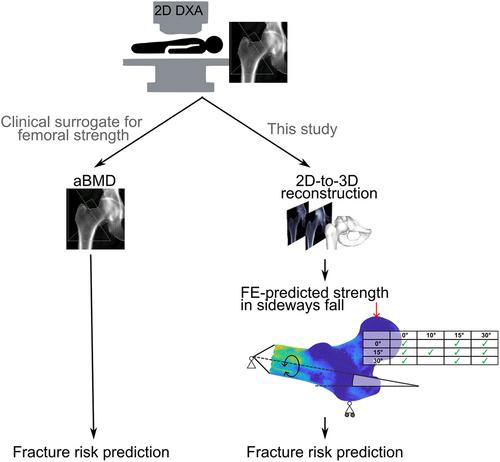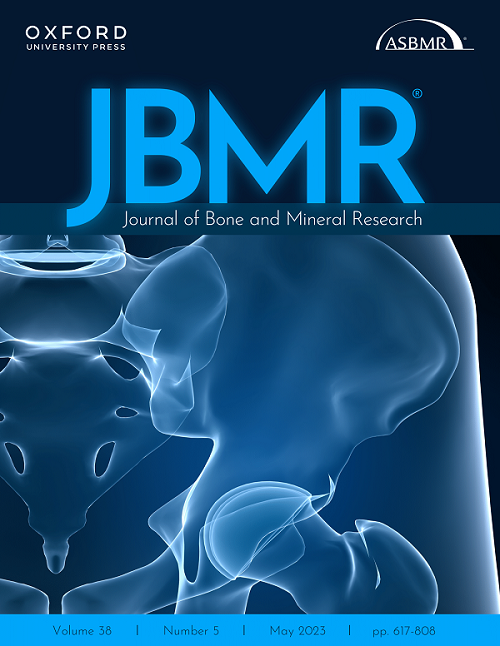Lorenzo Grassi, Sami P. V??n?nen, Lars Jehpsson, ?sten Ljunggren, Bj?rn E. Rosengren, Magnus K. Karlsson, Hanna Isaksson
下载PDF
{"title":"根据2D双能X射线吸收法(DXA)图像重建的三维有限元模型与瑞典男性骨质疏松性骨折患者区域BMD相比,改善了髋部骨折预测","authors":"Lorenzo Grassi, Sami P. V??n?nen, Lars Jehpsson, ?sten Ljunggren, Bj?rn E. Rosengren, Magnus K. Karlsson, Hanna Isaksson","doi":"10.1002/jbmr.4878","DOIUrl":null,"url":null,"abstract":"<p>Bone strength is an important contributor to fracture risk. Areal bone mineral density (aBMD) derived from dual-energy X-ray absorptiometry (DXA) is used as a surrogate for bone strength in fracture risk prediction tools. 3D finite element (FE) models predict bone strength better than aBMD, but their clinical use is limited by the need for 3D computed tomography and lack of automation. We have earlier developed a method to reconstruct the 3D hip anatomy from a 2D DXA image, followed by subject-specific FE-based prediction of proximal femoral strength. In the current study, we aim to evaluate the method's ability to predict incident hip fractures in a population-based cohort (Osteoporotic Fractures in Men [MrOS] Sweden). We defined two subcohorts: (i) hip fracture cases and controls cohort: 120 men with a hip fracture (<10 years from baseline) and two controls to each hip fracture case, matched by age, height, and body mass index; and (ii) fallers cohort: 86 men who had fallen the year before their hip DXA scan was acquired, 15 of which sustained a hip fracture during the following 10 years. For each participant, we reconstructed the 3D hip anatomy and predicted proximal femoral strength in 10 sideways fall configurations using FE analysis. The FE-predicted proximal femoral strength was a better predictor of incident hip fractures than aBMD for both hip fracture cases and controls (difference in area under the receiver operating characteristics curve, ΔAUROC = 0.06) and fallers (ΔAUROC = 0.22) cohorts. This is the first time that FE models outperformed aBMD in predicting incident hip fractures in a population-based prospectively followed cohort based on 3D FE models obtained from a 2D DXA scan. Our approach has potential to notably improve the accuracy of fracture risk predictions in a clinically feasible manner (only one single DXA image is needed) and without additional costs compared to the current clinical approach. © 2023 The Authors. <i>Journal of Bone and Mineral Research</i> published by Wiley Periodicals LLC on behalf of American Society for Bone and Mineral Research (ASBMR).</p>","PeriodicalId":185,"journal":{"name":"Journal of Bone and Mineral Research","volume":"38 9","pages":"1258-1267"},"PeriodicalIF":5.1000,"publicationDate":"2023-07-07","publicationTypes":"Journal Article","fieldsOfStudy":null,"isOpenAccess":false,"openAccessPdf":"https://onlinelibrary.wiley.com/doi/epdf/10.1002/jbmr.4878","citationCount":"0","resultStr":"{\"title\":\"3D Finite Element Models Reconstructed From 2D Dual-Energy X-Ray Absorptiometry (DXA) Images Improve Hip Fracture Prediction Compared to Areal BMD in Osteoporotic Fractures in Men (MrOS) Sweden Cohort\",\"authors\":\"Lorenzo Grassi, Sami P. V??n?nen, Lars Jehpsson, ?sten Ljunggren, Bj?rn E. Rosengren, Magnus K. Karlsson, Hanna Isaksson\",\"doi\":\"10.1002/jbmr.4878\",\"DOIUrl\":null,\"url\":null,\"abstract\":\"<p>Bone strength is an important contributor to fracture risk. Areal bone mineral density (aBMD) derived from dual-energy X-ray absorptiometry (DXA) is used as a surrogate for bone strength in fracture risk prediction tools. 3D finite element (FE) models predict bone strength better than aBMD, but their clinical use is limited by the need for 3D computed tomography and lack of automation. We have earlier developed a method to reconstruct the 3D hip anatomy from a 2D DXA image, followed by subject-specific FE-based prediction of proximal femoral strength. In the current study, we aim to evaluate the method's ability to predict incident hip fractures in a population-based cohort (Osteoporotic Fractures in Men [MrOS] Sweden). We defined two subcohorts: (i) hip fracture cases and controls cohort: 120 men with a hip fracture (<10 years from baseline) and two controls to each hip fracture case, matched by age, height, and body mass index; and (ii) fallers cohort: 86 men who had fallen the year before their hip DXA scan was acquired, 15 of which sustained a hip fracture during the following 10 years. For each participant, we reconstructed the 3D hip anatomy and predicted proximal femoral strength in 10 sideways fall configurations using FE analysis. The FE-predicted proximal femoral strength was a better predictor of incident hip fractures than aBMD for both hip fracture cases and controls (difference in area under the receiver operating characteristics curve, ΔAUROC = 0.06) and fallers (ΔAUROC = 0.22) cohorts. This is the first time that FE models outperformed aBMD in predicting incident hip fractures in a population-based prospectively followed cohort based on 3D FE models obtained from a 2D DXA scan. Our approach has potential to notably improve the accuracy of fracture risk predictions in a clinically feasible manner (only one single DXA image is needed) and without additional costs compared to the current clinical approach. © 2023 The Authors. <i>Journal of Bone and Mineral Research</i> published by Wiley Periodicals LLC on behalf of American Society for Bone and Mineral Research (ASBMR).</p>\",\"PeriodicalId\":185,\"journal\":{\"name\":\"Journal of Bone and Mineral Research\",\"volume\":\"38 9\",\"pages\":\"1258-1267\"},\"PeriodicalIF\":5.1000,\"publicationDate\":\"2023-07-07\",\"publicationTypes\":\"Journal Article\",\"fieldsOfStudy\":null,\"isOpenAccess\":false,\"openAccessPdf\":\"https://onlinelibrary.wiley.com/doi/epdf/10.1002/jbmr.4878\",\"citationCount\":\"0\",\"resultStr\":null,\"platform\":\"Semanticscholar\",\"paperid\":null,\"PeriodicalName\":\"Journal of Bone and Mineral Research\",\"FirstCategoryId\":\"3\",\"ListUrlMain\":\"https://onlinelibrary.wiley.com/doi/10.1002/jbmr.4878\",\"RegionNum\":1,\"RegionCategory\":\"医学\",\"ArticlePicture\":[],\"TitleCN\":null,\"AbstractTextCN\":null,\"PMCID\":null,\"EPubDate\":\"\",\"PubModel\":\"\",\"JCR\":\"Q1\",\"JCRName\":\"ENDOCRINOLOGY & METABOLISM\",\"Score\":null,\"Total\":0}","platform":"Semanticscholar","paperid":null,"PeriodicalName":"Journal of Bone and Mineral Research","FirstCategoryId":"3","ListUrlMain":"https://onlinelibrary.wiley.com/doi/10.1002/jbmr.4878","RegionNum":1,"RegionCategory":"医学","ArticlePicture":[],"TitleCN":null,"AbstractTextCN":null,"PMCID":null,"EPubDate":"","PubModel":"","JCR":"Q1","JCRName":"ENDOCRINOLOGY & METABOLISM","Score":null,"Total":0}
引用次数: 0
引用
批量引用


 求助内容:
求助内容: 应助结果提醒方式:
应助结果提醒方式:


